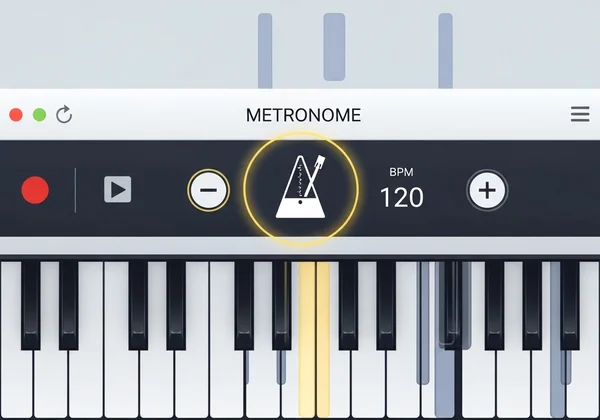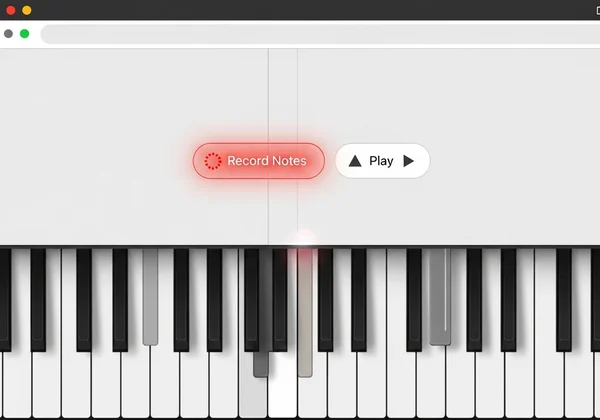Online Piano Keyboard: Master Rhythm with Metronome & Recording
Rhythm truly is music's heartbeat – that steady pulse transforming notes into captivating melodies. Yet, for many aspiring pianists, mastering rhythm can be a significant challenge. Are you struggling to keep time while playing piano? Do your melodies feel rushed, slow, or just slightly off-beat? You're not alone. Developing a solid sense of timing is a crucial step for every musician, and our online piano is here to help.
On our platform, we believe that learning piano should be accessible and enjoyable for everyone. That's why we’ve built powerful, free tools right into our platform to help you develop impeccable timing. This guide will show you exactly how to use our integrated metronome and recording features. You’ll learn to sharpen your piano rhythm, track your progress, and play with confidence. Ready to feel the beat? Let's start your lessons today.

Understanding Piano Rhythm Basics
Before diving into the tools, it’s essential to understand why rhythm is so fundamental. Rhythm is what gives music its structure and flow. Without a consistent tempo, even a simple tune can sound confusing and disjointed. For anyone learning to play piano online, a strong rhythmic foundation is the key to unlocking more complex and expressive pieces later on. It builds muscle memory and internalizes the pulse of the music.
Why Rhythm Matters for Your Online Piano Journey
When you practice piano online, you are your own teacher in many ways. A physical instructor might tap their foot or clap to keep you on beat, but our virtual tools can serve the same purpose. Mastering rhythm early in your online piano journey ensures that you build good habits from the start. It helps with coordination between your hands and makes learning new songs significantly easier because you can break them down by their rhythmic patterns.
Key Elements of Musical Timing: Beat, Tempo, & Meter
To talk about rhythm, we need to know a few basic terms. These concepts are the building blocks of musical time and are essential for using our practice tools effectively.
- Beat: This is the basic, repeating pulse in a piece of music. Think of it as the steady "tap-tap-tap" you might nod your head to.
- Tempo: This refers to the speed of the beat, measured in beats per minute (BPM). A slow ballad might have a tempo of 60 BPM, while an upbeat pop song could be 120 BPM or faster.
- Meter: Also known as the time signature, meter organizes beats into regular patterns. The most common meter is 4/4, which means there are four beats in every measure. You would count it "1-2-3-4, 1-2-3-4."
Understanding these elements will empower you to use our virtual piano keyboard not just for playing notes, but for truly making music.
Master Your Timing with Our Online Metronome
One of the most effective tools for improving rhythm is a metronome. It provides a steady, audible click that acts as your unwavering guide. The online metronome built into our platform is designed to be simple, effective, and always available. No need for extra apps or devices; it's right there on your screen, ready to help you lock into the beat.
How to Access and Adjust the Metronome on Our Virtual Piano
Getting started with our metronome is incredibly easy. When you load our free online piano, you'll see a toolbar with several icons.
-
Find the Metronome Icon: Look for the icon that resembles a classic metronome.
-
Turn It On: Simply click the icon to activate the metronome. You’ll immediately hear a steady click.
-
Adjust the Tempo (BPM): Next to the icon, you'll see a number representing the BPM. You can click the "+" or "-" buttons or type in a specific number to set the tempo to your desired speed. Start slow and gradually increase the speed as you get more comfortable.

Effective Metronome Practice Techniques for Piano Beginners
Simply turning on the metronome is a great first step, but using it with specific practice techniques will accelerate your progress. Start by playing a simple C Major scale. Set the metronome to a slow tempo, like 60 BPM, and play one note for every click. Focus on making your key press happen at the exact same moment as the click.
Once you are comfortable with that, try playing two notes for every click (eighth notes). This trains your brain and fingers to understand subdivisions of the beat. Using the metronome consistently will build an internal clock that becomes second nature, making your playing sound more professional and polished. Our piano simulator makes this kind of focused practice simple and accessible.
Track Your Progress: How to Record Piano Notes Online
How do you know if your rhythm is actually improving? The answer is to listen to yourself. The ability to record piano notes online is another powerful feature of our virtual piano. It acts as an honest mirror, allowing you to hear your performance from an objective perspective and pinpoint areas that need work.
Step-by-Step Guide to Recording Your Piano Performance
Recording your practice sessions is as straightforward as using the metronome. You don't need any special software—it's all built into our tool.
-
Locate the "Record Notes" Button: On the toolbar, find the button labeled "Record Notes."
-
Start Recording: Click it to begin. The button will change to indicate that it is actively recording every note you play.
-
Play Your Piece: Perform the scale, chord progression, or song you are practicing. Try playing along with the metronome for the best results.
-
Stop and Playback: Click the button again to stop recording. Then, press the "Play" button to hear your performance back.

Listening Back: Analyzing Your Recorded Piano Notes for Improvement
This is where the magic happens. When you engage in listening back to your recording, pay close attention to your timing. Are your notes aligning perfectly with the metronome's click? Are there spots where you speed up or slow down unintentionally? Hearing these inconsistencies is the first step to correcting them.
Record yourself playing the same short piece every day for a week. By comparing the recordings, you'll gain tangible evidence of your improvement. You can even download your recordings as MP3 files to keep a log of your progress or share them with a teacher or friend. This feature transforms our online piano keyboard into a comprehensive learning environment.

Beyond the Basics: Advanced Rhythm Exercises & Tips
Once you've mastered the basics of staying on beat, you can explore more complex rhythmic ideas. This will make your playing more dynamic and interesting. Our platform is perfect for experimenting with these concepts without any pressure.
Syncopation and Polyrhythms: Expanding Your Rhythmic Vocabulary
Syncopation is the art of playing off the main beat, emphasizing the weaker beats to create a groovy, exciting feel. Think of ragtime or jazz music. Polyrhythms involve playing two different rhythms at the same time, such as three notes in the right hand for every two notes in the left. While these concepts sound advanced, you can start exploring them simply by using our recording and playback features to experiment.
Troubleshooting Common Rhythm Mistakes and How Our Platform Helps
A common mistake for beginners is rushing through difficult passages or slowing down unintentionally. By recording yourself with the metronome, you can instantly identify these tendencies. If you notice you're rushing, practice that specific section at a much slower tempo until it feels effortless. Then, gradually increase the BPM. The ability to isolate, record, and review makes it easy to practice piano online and fix mistakes efficiently.
Your Journey to Rhythmic Mastery with Our Online Piano
Developing a strong sense of rhythm is a journey, but it’s one of the most rewarding aspects of learning piano. By consistently using the free, powerful tools available on our virtual piano platform, you can transform your playing from hesitant to confident. The metronome will be your steady guide, and the recording feature will be your honest friend, providing the feedback you need to grow.
Don't let rhythm be a barrier to your musical expression. Embrace these tools, make them a regular part of your practice routine, and listen as your timing becomes sharp and reliable. The joy of playing in perfect time is just a few clicks away. Explore the keyboard now and take the first step toward rhythmic mastery!
Frequently Asked Questions About Rhythm & Online Piano Practice
Can a virtual piano truly help improve my rhythm?
Absolutely. A virtual piano platform provides essential tools that are crucial for rhythm development. The built-in metronome offers a consistent tempo reference, and the recording feature allows for immediate self-assessment, which are two of the most effective ways to practice and improve timing.
How do I know if my piano rhythm is improving with practice?
The best way is to record yourself. Use the "Record Notes" feature on our platform to capture your playing at the beginning of a practice session and again at the end. Compare the two recordings. You'll hear tangible improvements in your ability to stay on beat, play evenly, and maintain a steady tempo.
Is it important to always use a metronome when learning piano online?
While not every single moment of practice needs a metronome, it should be a regular part of your routine, especially when learning new pieces or working on technical exercises like scales. Using a metronome builds a strong internal clock. Once your timing is solid, you can practice without it to develop your musical expressiveness.
Can I save my recorded online piano practice sessions to listen later?
Yes, you can! Our platform allows you to download your recorded performances as MP3 files. This is perfect for tracking your long-term progress, sharing your creations with friends, or sending them to a music teacher for feedback. It's one of the many features that make our online tool a comprehensive solution for learners.